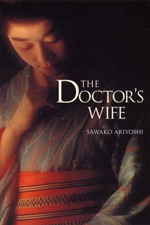

Kodansha International, paperback, 9784770029744
We all know that we shouldn't judge a book by its cover. But the cover of this new edition of the 1966 Japanese novella The Doctor's Wife tempted me to do just that. It is bright red, wrapped in forest green, adorned with the soft-focus image of a woman in a simple orange obi, no doubt the doctor's wife herself. Small enough to tuck into the hand, the book's design is both restrained and dramatic, like the story itself.
Even the title is ironic, as there are in fact two doctors' wives: the older and the younger. They are separated not only by age, but by physical attributes, life experience and social class. Their story lies within these dichotomies.
The book is a historical novel, placed in the late 18th/early 19th centuries, woven in and around the real life of Hanaoka Seishu, the first doctor to use general anesthetic. At that time, a doctor was usually a man of low status and modest income. Most relied on land holdings to provide income. Seishu's grandfather, however, chose to dedicate his life exclusively to medicine, and his son and grandsons followed in his footsteps.
Legend tells us that Seishu's mother Otsugi was a woman of class and wealth whose husband won her by agreeing to cure her of a terrible skin condition in exchange for her hand in marriage. Otsugi, the first doctor's wife in the story, was considered a great beauty, and when her son Seishu was still in medical school, she procured for him a less beautiful wife, Kae. Although beyond her prime at twenty one, Kae had the distinction of coming from a higher social class.
As the author imagines it, the young Kae, who will be the second doctor's wife, comes eagerly to the extended family home of the doctors, even though she leaves a life of leisure for one of hardship. Kae has admired the beautiful Otsugi from afar since childhood, and wants nothing more than to be close to the elegant older woman. Seishu marries Kae in absentia and will not meet her until three years later, when he returns from medical school. But during those first three years, Kae lives in his home and becomes a part of his family, joining Oksugi and her husband the elder doctor, as well as Seishus's many siblings.
Horror stories abound in traditional cultures where a young woman must forsake her family for the home of her new husband. The young wife may be used as a slave and treated with cruelty or neglect by her new family, most often her mother-in-law. Initially, this is not the case for young Kae. During the early years, Otsugi and Kae bond to such an extraordinary degree that they are virtually mother and daughter. But all this changes when Seishu returns home and the women enter a power struggle for his love. Because they are proper ladies, Kae and Otsugi wage a battle that is subtle, seething, adept and virtually invisible to the rest of the household, especially its men. In an extraordinary ascending scale of sacrifice, the women give all they have to give, and the result is Seishu's rise to fame, wealth and historic success as a surgeon.
The author Sawako Ariyoshi, a writer of great popularity in Japan before her death in 1984, imagines these women and
the circles of their influence to reveal much that is true in the lives of women the world over. Most fascinating here,
and most poignant, is the way we see the women build their men as they build themselves, then continue to build their
men as they destroy themselves. At the end of such true-life sagas, the men generally prosper, and the women are
forgotten. But not this time, thanks to this fine book and the power of Ariyoshi's pen.
